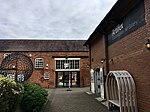Manley Hall, Staffordshire
British architect stubsBritish country houses destroyed in the 20th centuryBuildings and structures demolished in 1905Country houses in StaffordshireDemolished buildings and structures in England ... and 1 more
Houses completed in 1833
Manley Hall (also known as Thickbroom Hall) was an English Tudor-style country house in Weeford, near Lichfield in Staffordshire. The house was built in 1833 in a 1200-acre estate for John Shawe Manley, who in 1843 was High Sheriff of Staffordshire. It was designed by architect Thomas Trubshaw (1801–1842) of Little Haywood. The building included a watch tower and elaborate finials and chimneys. However, due to severe wood rot, Manley Hall, apart from the south-west end, was demolished in 1905. On the estate today there is an open lawn where the house used to stand and Manley Wood. Plans are in hand to convert the service wing and the stable block to dwelling houses.
Excerpt from the Wikipedia article Manley Hall, Staffordshire (License: CC BY-SA 3.0, Authors).Manley Hall, Staffordshire
Little Hay Lane, Lichfield
Geographical coordinates (GPS) Address Nearby Places Show on map
Geographical coordinates (GPS)
| Latitude | Longitude |
|---|---|
| N 52.628927777778 ° | E -1.8105777777778 ° |
Address
Little Hay Lane
Little Hay Lane
WS14 0PZ Lichfield
England, United Kingdom
Open on Google Maps







